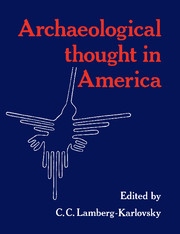Book contents
- Frontmatter
- Contents
- List of illustrations
- Introduction
- Part I History, method, and theory
- 1 History and contemporary American archaeology: a critical analysis
- 2 Aspects of the application of evolutionary theory in archaeology
- 3 The “New Archaeology,” then and now
- 4 Marxism in American archaeology
- 5 Formal approaches in archaeology
- 6 Ideology and evolutionism in American archaeology: looking beyond the economic base
- 7 The present and the future of hunter-gatherer studies
- 8 Paleopathology and the interpretation of economic change in prehistory
- Part II Archaeology in the Americas and beyond
- References
- Index
6 - Ideology and evolutionism in American archaeology: looking beyond the economic base
Published online by Cambridge University Press: 06 July 2010
- Frontmatter
- Contents
- List of illustrations
- Introduction
- Part I History, method, and theory
- 1 History and contemporary American archaeology: a critical analysis
- 2 Aspects of the application of evolutionary theory in archaeology
- 3 The “New Archaeology,” then and now
- 4 Marxism in American archaeology
- 5 Formal approaches in archaeology
- 6 Ideology and evolutionism in American archaeology: looking beyond the economic base
- 7 The present and the future of hunter-gatherer studies
- 8 Paleopathology and the interpretation of economic change in prehistory
- Part II Archaeology in the Americas and beyond
- References
- Index
Summary
Even with contemporary societies the analysis of religion presents formidable conceptual, epistemological, and methodological obstacles. It is not surprising then that extensive studies of ideology in archaeology have traditionally been largely derived from historical and proto-historic sources rather than prehistoric evidence. The study of prehistoric religion and ideology in Old World archaeology relied heavily upon Biblical texts, Mesopotamian tablets, Classical mythology, and other historic and proto-historic sources. Similarly, in American archaeology and anthropology most early analyses of New World religious systems were based directly or indirectly on written records (Demarest 1987). Studies of the religious systems of historic and proto-historic peoples (Aztec, Inka, Post-Classic Maya) were based on the Precolumbian codices, the conquistadors' chronicles, church and government surveys, and archives of legal records (e.g. Seler 1960–1; Caso 1945; Nicholson 1971; Leon-Portilla 1963, 1968a; Rowe 1946). Studies of religion in the prehistoric period were derived primarily from the art and iconography which, in turn, was interpreted through comparison to these same Conquest period sources (e.g., Covarrubias 1957; Leon-Portilla 1968b; Morley 1956; Joralemon 1971; Coe 1968:111–15, 1978). Such studies were sometimes successful in describing Precolumbian pantheons, rituals, and cosmologies, especially elite religious ideology. Beyond the direct historical approach, analysis of fully prehistoric ideology was left to those who were willing to apply unsystematic and subjective interpretations to ancient art or artifacts.
- Type
- Chapter
- Information
- Archaeological Thought in America , pp. 89 - 102Publisher: Cambridge University PressPrint publication year: 1989
- 12
- Cited by



